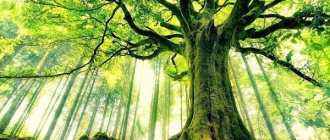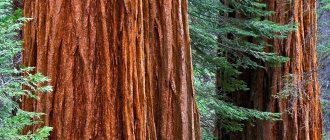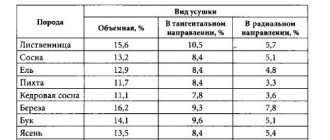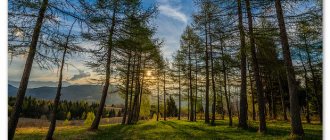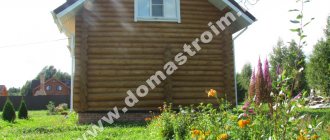iron tree
Among the very first tools that man began to use at the very dawn of civilization were not only bone and stone, but also wooden objects. Even then, still not knowing anything about such a concept as hardness, people noticed that different trees and shrubs have different wood in strength, the force with which tools made from it can influence other objects without being damaged or destroyed. This is where people came to the concept of hardness. Trees that had the highest indicators for this characteristic were called “iron”.
It should be noted that in different areas, on different continents and continents, this name meant completely different tree species. But for the most part, in addition to high strength, they also had other similar parameters. In particular, the wood of these tree varieties:
- does not float on the surface or in the water column, but sinks to the bottom and drowns;
- these trees are very rarely affected by various diseases, harmful insects and other biological pests;
- it is difficult to process and so on.
Today, thanks to the high development of science and technology, people have penetrated into the most intimate secrets of nature, gained knowledge about biological and physical laws, and learned to determine the hardness of various materials. In particular, the following two main methods are used for testing wood: Brinell and Rockwell. They got their name from the names of the scientists who developed them and put them into practice. In the first case (according to Brinell), to diagnose the test sample, it is impacted using a special ball, and in the second (according to Rockwell) using a diamond tool. After the test is completed, a depression of varying depth remains on the surface of the material (wood). The hardness of the tree is judged by its size.
For some types of wood, this parameter is so high that it exceeds the values of a similar characteristic for metals and their alloys. The wood of such trees, called “iron” trees, is used by people to solve various problems. It was used in the past and is being produced now:
- nails;
- furniture;
- structural parts and assemblies of complex machines and units;
- construction fixtures and elements, and so on.
The strength indicator of different trees of the same variety is influenced by:
- age, the older the tree, the stronger it is, since wood loses moisture over time and “dries out”;
- climatic characteristics of the place of growth, in arid regions the hardness of wood will be higher than in humid ones, at low temperatures, the growth of seedlings and planting material slows down, which also leads to an increase in hardness;
- the method that craftsmen used when cutting wood;
- the section of wood from which the sample was made, the hardness at the surface, directly under the bark and in the core of the trunk differs, at the bark it is higher.
A high hardness index can be both an advantage and a disadvantage of wood, depending on the intended method of use. In most cases, ironwood wood has a very beautiful texture and unusual color, so it is especially in demand in the production of various furniture and furnishings. As positive factors inherent in them and associated with the high hardness of wood, one can note increased wear resistance, low maintenance requirements, no need for additional processing or impregnation with pest control agents. The negative aspects include: the significant cost of the material, difficulty in processing, difficulties in assembly, fixing furniture on the wall, and repairs.
Varieties of "iron trees"
As mentioned earlier, there are many trees with high hardness ratings that are classified as “iron trees”. Among the most widely used in production, construction, and for making furniture, the following can be mentioned.
Jatoba - Brazilian cherry
In the tropical forests of Central and South America grows a tree called the South American (Brazilian) cherry. The height of individual specimens can exceed 40 m. Young shoots, pubescent with small brownish hairs, form a wide crown. The compound leaves are composed of two pointed, crescent-shaped leaves measuring 7.5 cm in length.
The South American plant is not a relative of the cherry fruit tree, which is widespread in our country. Perhaps the plant received this name because of the wood, the core of which is dark red or deep orange. After cutting, within a week it very quickly acquires a dark, brick-red hue.
Jatoba is one of the hardest species (7 Brinell points) used for making furniture and decorative elements.
Sucupira
This is another representative of the South American flora, growing in the forest thickets of Colombia, Brazil, and Venezuela. Expressive texture, small, narrow yellowish or light veins on dull reddish-brown wood, lighter towards the edges, make it easily recognizable and very decorative. In addition to high hardness and strength, the distinctive quality of sucupira is the presence in the layers of wood of oily substances that prevent the development of diseases, damage by combs and other pests.
Hardness of about 5.6 points complicates the process of cutting wood, which requires strict adherence to technology, failure to comply with which can lead to damage to all harvested raw materials. But the processing (sanding, polishing) is quite simple, which makes it possible to obtain from it a high-quality, beautiful parquet flooring in a wide range of colors from cocoa with milk to a burgundy shade. Products made from sucupira do not fade under the influence of ultraviolet rays and are not affected by fungus or harmful insects.
About 100 years pass from planting until the plant reaches maturity, but once the tree reaches 25 years of age, it can be processed. At this time, its trunk is almost cylindrical, devoid of side branches and shoots.
Turmoil
In the West African tropical rainforests, a very interesting tree grows, reaching 50-60 m in height, with a trunk diameter of about 1 m. The color of its wood resembles the color of a walnut, and the structure is teak. This type of wood is called mutania. It belongs to the “iron” category, since its hardness value is 5 points. However, this value is not always sufficient and in some cases it can be damaged by mechanical stress.
Muthenia wood is valued by furniture makers and builders because it does not crack or warp during the drying process, and when cut, radial rays of a violet hue “appear” on it. High hygroscopicity does not allow wood to be treated with varnish or primer. But you don’t need to do this, because it has an original natural shine. Furniture is made from muthenia wood, it is used for interior decoration, and is used in the production of parquet and veneer.
Intsia
Under the name merbau, wood of various types of intsia is widely used in European countries for the manufacture of parquet. Possessing high hardness (4.9 Brinell points), it is even suitable for laying floors in public buildings. In addition, it has increased moisture resistance, which makes it possible to use it in bathrooms, baths, and saunas.
The distribution area of Intsia is South Asia, Oceania, New Guinea, Madagascar. The plant belongs to the legume family. The height of individual specimens reaches 30-50 meters, the trunk diameter is 1.5 m. At the same time, there are practically no lateral branches on the trunk.
Merbau wood has a range of colors from light orange to yellow. After sawing, processing, and polishing, the surface of the wood becomes brownish and acquires a beautiful silver or bronze tint.
Canadian maple
The national flag of Canada is decorated with a stylized image of a maple leaf, since the sugar maple (Canadian) is a symbol of this country. Acer saccharum is a deciduous tree belonging to the Sapindaceae family. It occupies vast areas in North America. Maple also grows in our country, and recently it has been actively used in Europe as an ornamental plant to decorate gardens, parks, and public gardens.
The lifespan of one plant can be 400 years. During this time, it grows to 30-40 m in height, the thickness of the trunk reaches 1 m. The decorative appearance of the maple tree is given by its picturesque crown, consisting of small, about 11 cm in length and width, leaves of an original shape. In summer they are dark green, with the onset of autumn they acquire red, orange, and yellow shades.
In addition to its decorative properties, Acer saccharum has a sweetish-tasting sap, which can be collected in early spring and used in cooking, and durable, hard (4.8 Brinell points) wood, widely used for making furniture, expensive musical instruments, parquet, cladding panels, butts. for weapons and even bowling pins.
Yarra (eucalyptus)
In total, about 700 species of eucalyptus, trees from the myrtle family (Myrtaceae), grow in Australia. They grow very rapidly, especially at a young age, adding up to 5 m in height per year. The height of an adult plant is about 40-50 m. Among the features of eucalyptus: the ability to “shed” the bark in the fall, the arrangement of the leaves with their edges facing the sun, so they do not provide shade at all, the beautiful dark red to light pink color of the wood, the texture reminiscent of mahogany (mahogany) and high hardness (5 Brinell points).
Yarra – Eucalyptus marginata wood, dense, hard and flexible, can be easily processed: polished, sanded. But it has a drawback - it is very difficult to cut it perfectly straight. The main use of jarrah wood is decoration and cladding of yachts, boats, and buildings in areas with high humidity.
Pink tree
A very unusual tree, Dalbergia decipularis or bahia, grows in the Amazon jungle. It grows only in the subtropics of Brazil and is notable for its hard wood (4.4 Brinell points) with a beautiful texture, coloring from yellow to pink, with small red touches. But what is especially surprising is its smell. Bahia gives off an aroma characteristic of rose bushes. Because of this, the plant received another name - rosewood.
The wood is highly polished and used in furniture production, for the manufacture of musical instruments (recorders, guitars), gift boxes for cigars (humidors), and for wood carving. But still, its main value is its essential oil, which has antiseptic and bactericidal properties. It is widely used in cosmetology, dermatology, and is used as an analgesic and sedative. In addition, it is a powerful aphrodesiac.
Ash
Ash, which can be found in almost all corners of our country, has elastic, durable and hard (4.0 Brinell points) wood. It belongs to the Maslinaceae genus and, with an average height of 25-35 m, can sometimes reach a height of 60 m. The diameter of the trunk usually does not exceed 1 m. The special hardness of ash wood was noticed by the ancient Novgorodians. They used it to make combat (bows, clubs) and hunting (horns, spears) weapons.
Oak
In our country, oak is a kind of standard of hardness. We say: “Strong as an oak” when we want to emphasize the character traits of a person who has a strong will and determination. However, when compared with other “iron” trees, its hardness is not that great, only 3.8 Brinell points. Oak, a member of the Beech family, can grow both as a tree and as a shrub. Depending on the growing conditions, its wood varies in strength, strength, and heaviness. It is used as an ornamental wood, for the production of furniture, musical instruments, and as timber.
Large deciduous tree with strong wood, 3 letters
- Word search
- Crossword answers
- Large deciduous tree with strong wood, 3 letters
/
/
oak
The word "oak" consists of 3 letters:
- first letter D
- second letter U
- third letter B
Look up the meaning of the word “oak” in the dictionary.
Alternative definitions for the word “oak”, a total of 76 variants found:
- “Near Lukomorye... green”
- (jargon) ruble
- “I’ll be alive, I’ll see...” (palindrome)
- "Food" for the crippled saw
- In a Russian nursery rhyme, a raven sits on this tree and “plays a silver trumpet”
- century old tree
- Viktor Pavlov in "Obsession"
- Beloved of the thin rowan
- Tree
- Tree of Andrei Bolkonsky
- Tree in Lukomorye
- Wood for the magic flute
- Wood for Prince Guidon's bow
- Wood for parquet
- Tree with acorns
- Tree of the beech family with strong wood and acorn fruits
- Tree of the beech family, forest-forming species
- Tree with golden chain
- Tree, king of the forest
- The tree chosen by the Nightingale the Robber for his nest
- The tree that was undermined by the ungrateful Pig in Krylov's fable
- The tree from which Winnie the Pooh fell
- The tree with which the bull is compared
- The tree that has become a symbol of stupidity
- The tree that stood as the prince in the song "Alexandra"
- Tree-hero
- Tree witch in a dark blue forest
- The wood of which tree cracks a lot in severe frosts?
- Winemakers around the world consider its wood the best material for barrels.
- He was eaten by a crippled saw
- Its Latin name - Quercus - means "handsome", although for us it personifies strength and courage
- Acorns, tree
- An acorn that lived to old age
- Green tree near Lukomorye
- A golden chain hangs on it
- What wood was the magic flute in Mozart's opera made from?
- What kind of wood did the son of Tsar Saltan make his bow from when he came out of the barrel?
- This Czech language teacher turned out to be the stupidest, in Schweik's opinion, regimental officer
- Source of acorns
- Which tree, planted by the poet himself, grows on the shore of the Big Pond in Lermontov's Tarkhany Museum-Reserve?
- Which tree in the Druid calendar is dedicated to the day of the spring equinox?
- Painting by Isaac Levitan
- Painting by the French artist Jules Dupre “Big...”
- Movie character by Viktor Pavlov in the short story “Obsession” from “The Adventures of Shurik”
- Sorcerer in the dark blue forest
- The strength of this tree has become a symbol of stupidity
- Medicinal plant
- deciduous tree
- Lukomorn. tree with a mermaid on the branches
- Lukomore tree
- Best wood for barrels
- Pig's favorite tree
- An ancient tree loved by pigs
- Mighty Tree
- The mighty tree under which the Slavic wedding feasts took place
- On it hangs a “golden chain”, along which the fabulous Scientist Cat from Pushkin’s Lukomorye walks.
- The name of the operation during which, in the mountainous region of Abruzzo, a group of German paratroopers freed former Prime Minister Mussolini from custody
- Parquet wood
- Sailing cargo coastal ship
- Patriarch of the Russian forest
- Acorn perspective
- The fruits of this tree are considered the first bread of man, warriors were awarded a wreath of its leaves, the Slavs believed that rejuvenating apples grew on it, and only it was called a tree
- Underneath the pig ate acorns
- Second lieutenant from the novel by Jaroslav Hasek “The Adventures of the Good Soldier Schweik during the World War”
- Cork tree
- Sprouted and matured acorn
- The Romans dedicated this tree to Jupiter, the Greeks to Apollo, and the Slavs to Perun.
- Collection of short stories by Yuri Nagibin “Winter...”
- A bunch of leaves from this tree, cast in bronze or silver, is awarded to airmen and members of the United States Army in lieu of a second order or medal.
- By grinding its dried fruits in a coffee grinder, you can prepare a good-tasting “coffee” drink
- The old tree with which Andrei Bolkonsky compared himself
- Stelmuzhsky...
- Centennial or cork
- Stood by the Lukomorye (tale)
- Which father has sons wearing hats?
- The boastful tree from Krylov's fable
Queries that may be of interest:
- Words starting with "d"
- Words with "b" at the end
- Words starting with "du"
- Words ending with "ub"
- Words starting with oak
- Words ending with oak
- Make words from the word "oak"
